Biography
In more than 200 films made over 50 years, John Wayne saddled up to become the greatest figure of one of America’s greatest native art forms, the western.
 The movies he starred in rode the range from out-of-the-money sagebrush quickies to such classics as “Stagecoach” and “Red River.” He won an Oscar as best actor for another western, “True Grit,” in 1969. Yet some of the best films he made told stories far from the wilds of the West, such as “The Quiet Man” and “The Long Voyage Home.”
The movies he starred in rode the range from out-of-the-money sagebrush quickies to such classics as “Stagecoach” and “Red River.” He won an Oscar as best actor for another western, “True Grit,” in 1969. Yet some of the best films he made told stories far from the wilds of the West, such as “The Quiet Man” and “The Long Voyage Home.”
In the last decades of his career, Mr. Wayne became something of an American folk figure, hero to some, villain to others, for his outspoken views. He was politically conservative and, although he scorned politics as a way of life for himself, he enthusiastically supported Richard M. Nixon, Barry Goldwater, Spiro T. Agnew, Ronald Reagan and others who, he felt, fought for his concept of Americanism and anti-Communism.
But it was for millions of moviegoers who saw him only on the big screen that John Wayne really existed. He had not created the western with its clear-cut conflict between good and bad, right and wrong, but it was impossible to mention the word “western” without thinking of “the Duke,” as he was called.
By the early 1960’s, 161 of his films had grossed $350 million, and he had been paid as much as $666,000 to make a movie–although in his early days on screen, his salary ran to no more than two or three figures a week.
It was rarely a simple matter to find a unanimous opinion on Mr. Wayne, whether it had to do with his acting or his politics. Film critics were lavish in praise of him in some roles and shrugged wearily as they candled his less notable efforts; one critic, apparently overexposed to westerns, angered him by commenting, “It never Waynes, but it pours.”
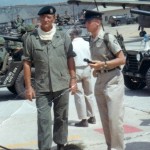
Mr. Wayne was co-director and star of “The Green Berets,” a 1968 film that supported the United States action in Vietnam. The movie was assailed by many major critics on all grounds, political and esthetic, but the public apparently did not mind; in only six months, it had earned $1 million above its production cost of $7 million.
Won Growing Respect
As the years passed, Mr. Wayne was recognized as some sort of American natural resource, and his various critics, political and film, looked on him with more respect. Abbie Hoffman, the radical of the 1960’s paid tribute to Mr. Wayne’s singularity. Reviewing “The Cowboys,” made in 1972, Vincent Canby, film critic of The New York Times, who did not particularly care for it, wrote, “Wayne is, of course, marvelously indestructible, and he has become an almost perfect father figure.”
But years before he became anything close to a father figure, Mr. Wayne had become a symbolic male figure, a man of impregnable virility and the embodiment of simplistic, laconic virtues, packaged in a well-built 6-foot-4-inch, 225- pound frame.
He had a handsome and hearty face, with crinkles around eyes that were too lidded to express much emotion but gave the impression of a man of action, an outdoor man who chafed at a settled life. He was laconic on screen. And when he shambled into view, one could sense the arrival of coiled vigor awaiting only provocation to be sprung. His demeanor and his roles were those of a man who did not look for trouble but was relentless in tackling it when it affronted him. This screen presence emerged particularly under the ministrations of John Ford and Howard Hawks, the directors.
Overcame Great Odds
Appearances were not altogether deceiving. Mr. Wayne loved adventure and the outdoors. He did believe that things were either right or wrong, and he came back against great odds. In 1964, a malignant tumor was removed from his chest and left lung, and within several months he was on location making another movie.
More recently, he found himself the target of much hate mail from the right wing, whose political idol he had been, after he supported President Carter’s espousal of the Panama Canal treaties. He did not mind. Although his basic views had not moderated, his tolerance, it seemed, had. He had even shown up at a function to congratulate Jane Fonda, who was to the left what he was to the right, on winning a screen award.
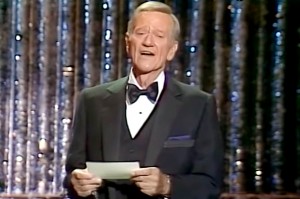 Mr. Wayne made his last public appearance at the Academy Awards ceremony in April, where he drew an emotional standing ovation when he strode out on stage to present the Oscar for best picture.
Mr. Wayne made his last public appearance at the Academy Awards ceremony in April, where he drew an emotional standing ovation when he strode out on stage to present the Oscar for best picture.
He was recently presented with a special Congressional medal of the kind given to such national figures as the Wright Brothers.
Between his first starring role in “The Big Trail” in 1930, and his last one, as the most celebrated gunslinger in the West who finds he is dying of cancer in “The Shootist,” in 1976, Mr. Wayne shot his way through generations of film fans with little change in style or personality. He had consciously adapted his posture for that first movie and retained it. He was sometimes inseparable from it in the flesh.
Watched Movies Being Made
“When I started, I knew I was no actor and I went to work on this Wayne thing,” he once recalled. “It was as deliberate a projection as you’ll ever see. I figured I needed a gimmick, so I dreamed up the drawl, the squint and a way of moving meant to suggest that I wasn’t looking for trouble but would just as soon throw a bottle at your head as not. I practiced in front of a mirror.”
His entrance into films was as fortuitous as any made by a young fellow who grew up near the Hollywood badlands. But the Wayne saga actually started much farther east, in the small town of Winterset, Iowa, where he was born May 26, 1907, and was named Marion Michael Morrison.
His father, Clyde L. Morrison, had a drugstore, but when Marion was 6 years old, his father, because of ill health, moved the family to Southern California and became a homesteader with an 80-acre farm. Not long after, the family settled in Glendale, where Mr. Morrison again went and opened a pharmacy. His store was in the same building as a theater, and young Marion, who rose at 4 A.M. to deliver newspapers and then, after school and football practice, delivered orders from the store, went to the movies four or five times a week, free.
Even earlier, when he was 7, he had learned about horses and played cowboy. In Glendale, he saw movies being made at the Triangle Studios, where they often shot outdoor scenes. The link between horse and camera was yet to be forged, but the influences were there from the beginning. Along the way he had acquired the nickname “Duke.” It came from an Airedale terrier he had had, he used to say as he debunked press releases that tried to explain the moniker as some sort of rubbed-off nobility.
Came to Ford’s Attention
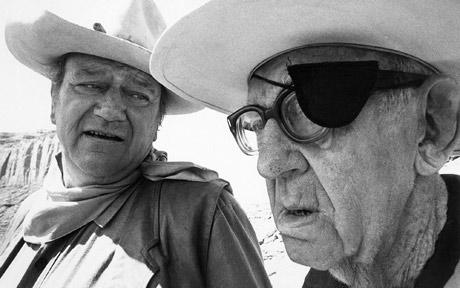 He worked as truck driver, fruit picker, soda jerk and ice hauler and was an honor student and a member of an outstanding football team at high school. His athletic talents brought him a football scholarship at the University of Southern California, but in his second year he broke an ankle and dropped out.
He worked as truck driver, fruit picker, soda jerk and ice hauler and was an honor student and a member of an outstanding football team at high school. His athletic talents brought him a football scholarship at the University of Southern California, but in his second year he broke an ankle and dropped out.
While he was still at school, he got a job, as other football players did, as a scenery mover at Fox Films. John Ford was attracted to the youth’s hulking physique and made him a “fourth-assistant prop boy.” When Mr. Ford was making a submarine film on location in the channel off Catalina Island, the regular stuntmen refused to go into the water because of rough seas. Mr. Ford asked the prop boy if he would. He did, immediately, and became part of the Ford team.
In an early film, Republic Pictures gave him a screen credit as Michael Burn and, in another, as Duke Morrison. When Raoul Walsh cast him as the star of “The Big Trail,” his expensive, $2 million western, the director thought that Marion was too sissified a name for a western hero, and “John Wayne” was born.
Rode in 40 Westerns
The movie was a flop. It had been shot as a talking picture on 72-millimeter film, a “superwestern” designed for large screens that required protection equipment that few movie houses were equipped with.
After two nonwesterns, Mr. Wayne retreated into short-order horse operas. Between 1933 and 1939, he made more than 40 westerns, all Grade B or C undertakings, interspersed with several that took him off the range but not into any particular recognition.
Then, like a good guy riding in to relieve the oppressed, his old benefactor, Mr. Ford, came along to cast Mr. Wayne as the Ringo Kid in the Oscar-winning “Stagecoach,” the 1939 movie that took westerns from the Saturday afternoon for-kids-only category and attracted the attention of more intellectual film critics. It was a turning point also for Mr. Wayne.
His next major role found him in a milieu far from the cactus sets. He played a simple Swedish lad in the crew of a freighter in “The Voyage Home,” Mr. Ford’s 1940 film based on the sea plays of Eugene O’Neill.
Mr. Wayne’s work from that point reads like a bill of lading of popular Hollywood wares. He starred with Marlene Dietrich in three films: “Seven Sinners” (1940), “Pittsburgh” (1943) and “The Spoilers” (1942). Others included Cecil B. De Mille’s “Reap the Wild Wind” (1942), as well as a slew of World War II movies that embraced Mr. Ford’s “They Were Expendable” in 1945.
Later came “Fort Apache” and “Red River,” in 1948, and “Three Godfathers” and “She Wore a Yellow Ribbon,” both in 1949. In 1952, Mr. Wayne showed off to best effect as the young Irish-American returned to Ireland in Mr. Ford’s “The Quiet Man.” It was a much-acclaimed film and is still a frequent feature on television.
Invested in ‘The Alamo’
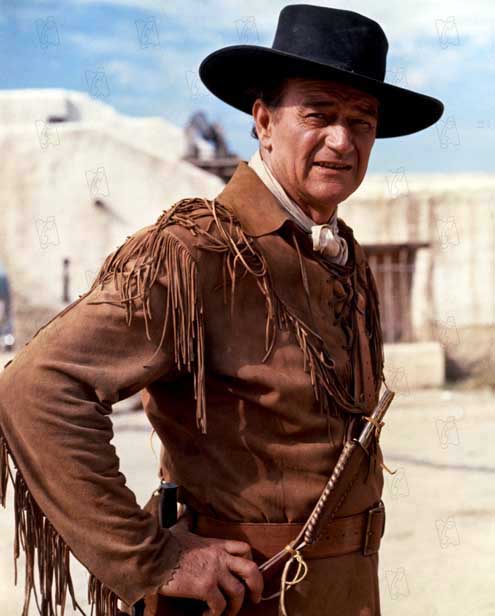 By the late 1940’s, Mr. Wayne had already been transformed from a dashing young adventurer to an older one, no less dashing, but in a somewhat more restrained tempo. In “Red River,” directed by Mr. Hawks, Mr. Wayne portrayed a ruthless cattle baron, not altogether a good guy, but one with some depth to him. In this instance, Montgomery Clift, the co-star, represented the forces for good.
By the late 1940’s, Mr. Wayne had already been transformed from a dashing young adventurer to an older one, no less dashing, but in a somewhat more restrained tempo. In “Red River,” directed by Mr. Hawks, Mr. Wayne portrayed a ruthless cattle baron, not altogether a good guy, but one with some depth to him. In this instance, Montgomery Clift, the co-star, represented the forces for good.
Mr. Wayne invested $1.2 million in 1960 to make “The Alamo,” about the fight between the Americans–the good guys–and the Mexicans–the bad guys. He played Davy Crockett. The picture was very dear to his heart because, he said, “We wanted to re-create a moment in history that will show this generation of Americans what their country still stands for . . what some of their forebears went through to win what they had to have or die*liberty and freedom.”
He was bitterly disappointed when the film failed. However, he quickly went on to other work: “The Man Who Shot Liberty Valance,” “Hatari” and “The Longest Day,” all in 1962; “How the West Was Won” in 1963, and “El Dorado” in 1967, another film directed by Mr. Hawks.
In 1969, Mr. Wayne was almost universally hailed when he starred in “True Grit,” directed by Henry Hathaway. Mr. Wayne played a disreputable, one-eyed, drunken, fat old man who was a Federal Marshal called Rooster Cogburn. In 1970, the Academy of Motion Picture Arts and Sciences awarded him an Oscar for his portrayal.
The success of “True Grit” led to “Rooster Cogburn,” in 1975, in which he co-starred with Katharine Hepburn in her first western.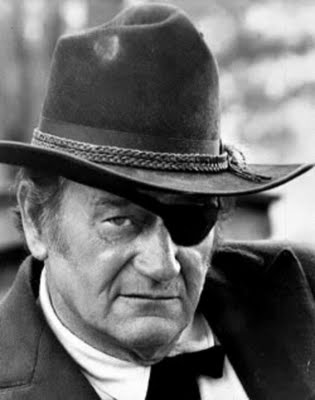
Mr. Wayne starred in his first television special, “Swing Out, Sweet Land,” a paean of patriotism, in 1970, and later became well-known for various television appearances. He never made a television series and had deep reservations about the medium’s approach to the western.
“Television has a tendency to reach a little,” he observed, referring to television westerns’ propensities for psychological insights. “In their westerns, they are getting away from the simplicity and the fact that those men were fighting the elements and the rawness of nature and didn’t have time for this couch-work.”
His anti-Communist sentiments led Mr. Wayne to help found the Motion Picture Alliance for the Preservation of American Ideals in 1944, and he was its president for two terms.
The organization, which eventually disbanded, was accused of having given the names of suspected Communists in the film industry to the House Committee on Un-American Activities, although Mr. Wayne said later that he had never been party to any such thing.
Once, interviewed about civil rights, he said: “I believe in white supremacy until the blacks are educated to the point of responsibility. I don’t believe in giving authority and positions of leadership and judgment to irresponsible people.”
He said that when he was in school, he was a “socialist,” but not for long. He said that he was a rebel, but not one like the youngsters of the late 60’s.
“Mine is a rebellion against the monotony of life,” he said. “The rebellion in these kids*particularly the S.D.S.’ers and those groups*seems to be a kind of dissension by rote.”
In his later years, Mr. Wayne, who had invested in oil and also in a shrimp business in Panama, among other things, became more financially conservative than he had been. He had not kept a very tight hand on his money earlier, and at one point realized he was not as well off as he had thought.
However, he was not impoverished. He lived with his third wife, Pilar Palette Wayne, who was born in Peru, in an 11-room, seven-bathroom, $175,000 house in Newport Beach, Calif., where he had a 135-foot yacht. He owned cattle ranches in Stanfield and Springerville, Ariz.
Mr. Wayne’s first two marriages, to Josephine Saenz and Esperanzo Bauer, also Latin Americans, ended in divorces. He had seven children from his marriages, and more than 15 grandchildren.
by Richard Shephard
Occupation: Actor, Director, Producer
Date of Birth: May 26, 1907
Date of Death: June 11, 1979
Place of Birth: Winterset, Iowa, USA
Sign: Sun in Gemini, Moon in Scorpio
Relations:
Father: Clyde Morrison (pharmacist)
mother: Mary Brown(d. 1970)
brother: Robert Morrison(d. 1970)
wives: Josephine Saenz (d.2003)
Esperanza Bauer(
Pilar Palette
last companion: Pat Stacey (d. 1995) (Wayne’s longtime assistant)Children:
Michael Wayne. Born November 23, 1934 / Died March 2003
Toni Wayne. Born 1936 / Died Dec. 2000
Patrick Wayne. Born July 15, 1939.
Melinda Wayne. Born 1940.
Aissa Wayne. Born 1956.
John Ethan Wayne. Born 1962.
Marisa Wayne. Born 1966.Education: Attended the University of Southern California on a football scholarship
Multimedia
John Wayne interviewed by Barbara Walters in 1979![]()
For more multimedia stuff go here
